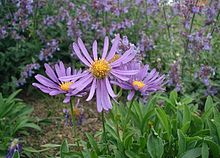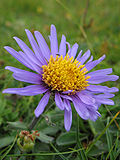Aster alpinus
| Aster alpinus | |
|---|---|

| |
| Scientific classification | |
| Kingdom: | |
| (unranked): | |
| (unranked): | |
| (unranked): | |
| Order: | |
| Family: | |
| Tribe: | |
| Genus: | |
| Species: | A. alpinus
|
| Binomial name | |
| Aster alpinus | |
| Synonyms[1] | |
| |
Aster alpinus (Alpine aster[2]) is an ornamental plant native to the mountains of Europe (including the Alps), with a subspecies native to Canada and the United States. It is a perennial forb having purple, pink or blue flowers belonging to the genus Aster.
Description

It grows to be about 6-12 inches (15–30 cm). The bloom color may be pink, violet/lavender, dark purple/black, or white/near white and may bloom in late spring/early summer or, occasionally, midsummer. In the UK this plant has gained the Royal Horticultural Society's Award of Garden Merit.[3]
Growth
It grows very slowly in clay, silt, loam, silty clay, sandy clay etc. types of soil. Its minimum pH Scale is 6 and maximum pH Scale is 7.5. It grows erectly in a 'single crown' form.
Ecology
It does better in generally cooler climates. Usually it is adapted to clay, silt, loam, silty clay, sandy clay, clay loam, silt loam, sandy loam, silty clay loam and sandy clay loam soils, and prefers low fertility. The plant can tolerate only a minimum temperature of -28°C / -18.4F after the occurrence of cell damage. It can survive medium heat of fire and requires at least 90 frost free days for proper growth. It is herbaceous and attractive to bees, butterflies, and birds.
Distribution
It is distributed in:[4]
| Asia-temperate | Europa | Northern America |
|---|---|---|
| Western Asia: Iran and Turkey | Middle Europe: Austria; Czech Republic; Slovakia; Germany; Poland; Switzerland | Subarctic America: Canada - Northwest Territory, Yukon Territory; United States - Alaska |
| Caucasus: Armenia; Azerbaijan; Georgia; Russian Federation - Ciscaucasia, Dagestan | East Europe: Russian Federation - Bashkortostan, European part, Komi, Perm; Ukraine | Western Canada: Canada - Alberta, British Columbia |
| Siberia: Russian Federation - Aga Buryat, Altay, Buryatia, Chelyabinsk, Chita, Gorno-Altay, Irkutsk, Kurgan, Novosibirsk, Omsk, Sverdlovsk, Tomsk, Tuva, Tyumen, Yakutia-Sakha | Southeastern Europe: Albania; Bulgaria; Former Yugoslavia; Greece; Italy; Romania | |
| Middle Asia: Kazakhstan ; Kyrgyzstan;Tajikistan | ||
| Russian Far East: Russian Federation - Chukchi, Kamchatka, Magadan | ||
| Mongolia: Mongolia | ||
| China: China - Hebei, Heilongjiang, Jilin, Liaoning, Nei Monggol, Shanxi, Xinjiang |
Conservation
In Canadian provinces, towards eastern North America, the species is critically imperiled. However, in both Canadian provinces and US states, at north-western and southern parts, the species is apparently secure.[5]
References
- ^ Aster alpinus information from NPGS/GRIN
- ^ A. alpinus at USDA Plants Profile
- ^ "RHS Plant Selector - Aster alpinus". Retrieved 11 June 2013.
- ^ NPGS/GRIN-Aster alpinus L. http://www.ars-grin.gov/cgi-bin/npgs/html/taxon.pl?5616
- ^ NatureServe Explorer Timeout Page
